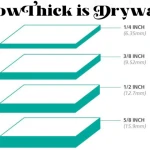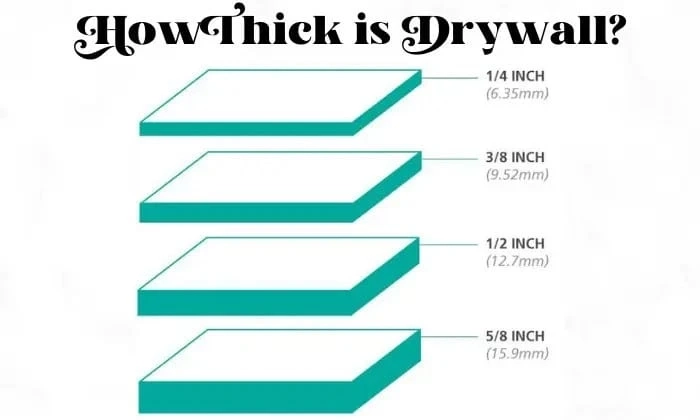It is very important to know the sizes and drywall thicknesses  before starting a building or remodeling job. Drywall, which is sometimes called gypsum board or plasterboard, is an important building material used to make walls and ceilings. This complete guide will talk about the different thicknesses of drywall, as well as the right dimensions and sizes for both home and business jobs.
before starting a building or remodeling job. Drywall, which is sometimes called gypsum board or plasterboard, is an important building material used to make walls and ceilings. This complete guide will talk about the different thicknesses of drywall, as well as the right dimensions and sizes for both home and business jobs.
Understanding Drywall Thickness
Drywall comes in several thicknesses, each serving a specific purpose. The most common thicknesses include 1/4 inch, 3/8 inch, 1/2 inch, 5/8 inch, and occasionally, 1 inch. Each thickness has its own set of applications and benefits, making it essential to choose the right one for your project.
1/4 Inch Drywall
1/4 inch drywall is the thinnest option available. It is typically used for:
- Curved Surfaces: Its flexibility makes it ideal for creating curved walls and arches.
- Overlaying: It can be used to cover existing walls and ceilings when additional layers are needed for insulation or soundproofing.
While 1/4 inch drywall is not as strong as thicker options, its lightweight nature and flexibility make it a versatile choice for specific applications.
3/8 Inch Drywall
3/8 inch drywall is slightly thicker and is often used in:
- Repairs: Ideal for repairing walls and ceilings where thinner drywall was originally used.
- Residential Applications: Suitable for use in older homes where walls may not be entirely even.
This thickness provides a bit more rigidity compared to 1/4 inch drywall but is still not as robust as thicker options.
1/2 Inch Drywall
1/2 inch drywall is the standard thickness for most interior walls and ceilings in residential construction. Its benefits include:
- Versatility: Suitable for most standard walls and ceilings.
- Availability: Widely available and cost-effective.
- Ease of Use: Easy to handle and install, making it a favorite among DIY enthusiasts.
This thickness provides a good balance between strength and weight, making it suitable for most residential applications.
5/8 Inch Drywall
5/8 inch drywall is thicker and more durable, often used in both residential and commercial projects for:
- Fire Resistance: Offers better fire resistance, making it suitable for fire-rated walls and ceilings.
- Soundproofing: Its additional thickness helps with sound insulation, reducing noise transmission between rooms.
- Sturdiness: Provides added strength, making it ideal for ceilings and walls that need to support heavy fixtures.
This thickness is often required by building codes in certain areas due to its fire-resistant properties.
1 Inch Drywall
1 inch drywall is not commonly used but serves specialized purposes in:
- High-Security Areas: Provides maximum durability and impact resistance.
- Soundproofing: Offers superior sound insulation, making it suitable for recording studios or other areas requiring minimal noise disruption.
This extra-thick drywall is heavy and challenging to install, often necessitating professional installation.
Drywall Sizes for Residential Projects
In residential construction, the most commonly used drywall sizes are:
- 4 x 8 Feet: Standard size, easy to handle and install, and fits well in most rooms.
- 4 x 12 Feet: Reduces the number of joints in larger rooms, providing a smoother finish.
The choice of size depends on the room\'s dimensions and the need to minimize joints, which can affect the overall appearance and structural integrity of the walls.
Drywall Sizes for Commercial Projects
Commercial projects often require larger and thicker drywall sizes to meet building codes and structural needs. Common sizes include:
- 4 x 12 Feet: Suitable for large commercial spaces, reducing the number of seams and joints.
- 4 x 14 Feet: Used in high ceilings or extensive wall areas to minimize joints.
- 4 x 16 Feet: Ideal for very large spaces, though challenging to handle and install.
The use of thicker drywall, such as 5/8 inch or even 1 inch, is more prevalent in commercial projects due to the need for increased fire resistance and soundproofing.
Specialized Drywall Types
In addition to thickness and size, drywall comes in various types designed for specific applications:
Moisture-Resistant Drywall
Moisture-resistant drywall often referred to as green board or blue board, this type is used in areas prone to moisture, such as:
- Bathrooms: Protects against mold and mildew growth.
- Kitchens: Provides additional moisture resistance behind sinks and stoves.
Fire-Resistant Drywall
Also known as Type X drywall, this type is designed to provide enhanced fire protection. It is commonly used in:
- Fire-Rated Walls: Required by building codes in certain areas.
- Garages: Provides an extra layer of fire resistance between living spaces and attached garages.
Soundproof Drywall
Soundproof drywall, often referred to as acoustic drywall, is used in areas where sound control is crucial, such as:
- Home Theaters: Reduces sound transmission for an immersive experience.
- Bedrooms: Provides a quieter living environment by minimizing noise from adjacent rooms.
Choosing the Right Drywall for Your Project
Selecting the appropriate drywall thickness and size depends on several factors:
- Room Size: Larger rooms benefit from larger drywall sheets to minimize seams.
- Functionality: Consider the specific needs of each room, such as moisture resistance for bathrooms or soundproofing for home theaters.
- Building Codes: Adhere to local building codes, which may dictate certain thicknesses for fire resistance and structural integrity.
Installation Tips
Proper installation is key to ensuring the longevity and performance of drywall. Here are some tips:
- Preparation: Ensure walls and ceilings are clean and dry before installation.
- Cutting: Use a sharp utility knife for clean cuts, and measure twice to ensure accuracy.
- Hanging: Start with the ceiling before moving to the walls, and use drywall screws or nails to secure the panels.
- Seaming: Apply joint tape and compound to seams for a smooth finish, sanding between coats to achieve a flawless surface.
Conclusion
Understanding the various thicknesses and sizes of drywall is essential for any construction or renovation project. Whether you\'re working on a residential or commercial project, selecting the right drywall ensures durability, fire resistance, and soundproofing. By considering the specific needs of your project and adhering to best installation practices, you can achieve professional-quality results that stand the test of time.



